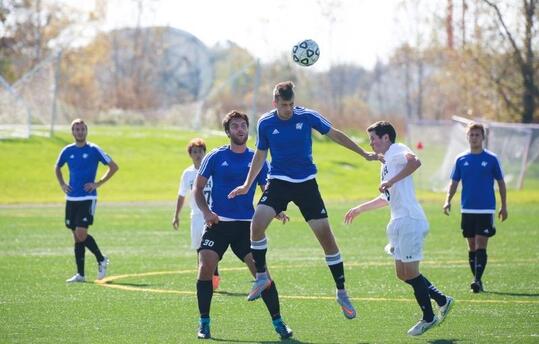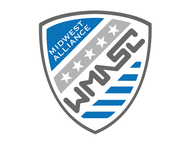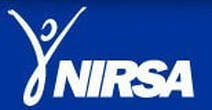
The Midwest Alliance Soccer Conference will be comprised of 58 conference members, from the states of Illinois, Indiana, Iowa, Michigan, Ohio and Wisconsin for the 2024 season.
Years ago, things were much different. Originally known as the Big Ten Conference, the league was made up of Michigan, Indiana, Illinois, Northwestern, Purdue and Iowa. In 1993, the Big Ten Conference added its first non-Big Ten member, Indiana State. In 1995, Purdue left the league, but later rejoined in 1998.
Later, in 1996, the Big Ten Conference added three new teams from the Ohio River Conference: Bowling Green, Ohio State and Ball State. Under the guidance of Steve Burns, former head coach of Michigan's Men's Varsity and Club Soccer Teams, the league changed its name to the NCSA Region III Conference and was affiliated with the now-folded National Collegiate Soccer Association. Each November, the conference sent its best teams to the NCSA (National Collegiate Soccer Association) National Championships which were held in Phoenix, Arizona. It was in 1996, that the MASC can look and identify as its charter year; with the clubs from Ball State, Bowling Green, Illinois, Indiana, Indiana State, Iowa, Michigan, Northwestern, and Ohio State solidifying the foundation for success and stability.
In 1997, there was a change in the administration of NCSA Region III. Eric Sztul, who at the time was a member as well as coach of the Bowling Green Men's Club Soccer Team, took over the leadership of the conference. In that season Toledo was added as a new league member. The league was becoming more well known and respected throughout the country, especially when Michigan won the NCSA National Championship.
In 1998, expansion was again occurring in the conference, adding Miami and Purdue. The competition and overall organization was also growing in the league, with as many as five teams going into national, post-season play. Once again, Michigan won the NCSA National Tournament.
1999 became a defining year for the conference. With the NCSA falling apart, and later dismantling, the conference had no identity, and no association with a governing body. As a whole, the league decided to join NIRSA (National Intramural and Recreational Sports Association). Joining NIRSA was the best decision for the conference. NIRSA provided weekly rankings and stable ground for a growing soccer league. The conference officially became known as the Midwest Alliance Soccer Conference, and added three new teams, bringing the total to fourteen. The new teams were Central Michigan, Ohio University and Western Michigan. The conference also sent three teams to the NIRSA National Championship that year.
Entering the new millennium, the MASC had a brand new look. Membership had risen to eighteen teams, with the additions of Grand Valley State, Northern Illinois, Xavier and Dayton. The league divided its competitors into two divisions, the East and West, which created many new rivalries. The conference sent three teams to the NIRSA National Tournament.
In 2001, the MASC had grown to 21 teams with the additions of former member Ball State, Eastern Michigan, Ferris State and Wright State. The league had expanded to three divisions and its teams continued to enjoy success at the National Tournament. There was also a change in leadership as Eric Sztul stepped down as League Commissioner, and was replaced by Dr. Jeff Harper, coach and team advisor for Indiana State University. Eric Sztul continued his leadership role as an Assistant Commissioner.
The MASC grew again for the 2002 season adding four new teams and bringing the total to 25 teams. Cincinnati, Michigan State, Southern Illinois and Western Illinois began play and league newcomer, Wright State, won their second consecutive tournament championship.
In 2003 there was another change of administration. Richard Becknell, former coach and advisor for the Ohio University Club team took the reigns of the league. With Becknell's insight, dedication, and passion for club soccer, the league continued to strive to be the best club soccer league in the country.
Later in 2004, several new clubs entered the conference, including Loyola-Chicago, Butler and Indiana University-South Bend. In 2005, an entire new division was added, the Great Lakes Division, which included clubs from both the Upper Peninsula of Michigan and the state of Wisconsin. The new addition brought the MASC into full geographic representation of NIRSA's Region III institutions, as well as marking the largest single expansion in league history. With the additions, the MASC became the largest collegiate club soccer conference in America.
The 2006 season was an unprecedented season as four member teams made the National Quarterfinals. In the National Championship, Michigan defeated Illinois in an epic battle. Two years later, Indiana University won the 2008 National Championship, thus continuing the long history of dominance for MASC clubs.
At the beginning of the 2011 season, the league had 42 league members, along with four associate member clubs. New leadership was also added with the addition of Andy Chabot, former player and team president of The Ohio State University Club Team. The conference also saw the change of location for the Regional Tournament with a move from Bloomington, Indiana to Lawrence Indiana. For the fourth straight season, the conference sent five league members to the NIRSA National Championships.
The 2012 campaign was another successful season as the level of competition and club organization continued to show improvement. Illinois won the Regional Tournament with a 1-0 victory over Ohio State. The league saw four teams qualify for the NIRSA National Championship with three teams advancing to the Sweet 16, two to the Elite 8, and Michigan State winning the National Championship.
In 2013, The Ohio State University Buckeyes beat Michigan State in an epic MASC Championship Game. Illinois, Cincinnati and Michigan qualified for the NIRSA National Championships. Unfortunately, Nationals was cancelled after the first day due to unforeseen rain that made the fields unplayable.
In 2014, at the Annual Spring Presidents Meeting, the league announced the addition of the Cleveland State University Vikings to replace Indiana State University. Cleveland State was added to the Eastern Division, Ball State University moved to the Central Division and Valparaiso University moved to the Western Division. Andy Chabot also took on the role as Conference Commissioner; becoming the conference's fifth commissioner. At the 2014 National Tournament in Memphis, TN, Ohio State won the National Championship; marking the Conference's sixth National Championship crown.
At the 2015 Annual Presidents Meeting, it was voted that the location of the tournament would change from Lawrence Soccer Park to the Grand Park Sports Complex in Westfield, Indiana. The Midwest Alliance Cup and its new venue was a gigantic success. Fans, coaches and players applauded the quality of the facility. The University of Wisconsin-Madison and the University of Michigan both claimed automatic bids to Nationals. At the 2015 NIRSA National Tournament, the University of Illinois lost in the semi-finals to eventual 2015 Champion UNC-Chapel Hill.
In 2016, Wheaton College was added as a new league member with Cleveland State leaving. Wheaton was placed in the Western Division and Valparaiso moved back to the Central Division. The Midwest Alliance Cup saw amazing excitement as The Ohio State University and Michigan State University both won automatic bids to the NIRSA National Championships. Later in mid November in Foley, Alabama, five MASC Clubs; Ohio State, Michigan State, UW-Madison, Michigan and Cincinnati fought to bring home a National Championship. All five teams won their groupings and advanced to the Sweet 16. Ohio State, UW-Madison and Cincinnati continued on to the Elite 8. Cincinnati and Ohio State made the Final Four. The Ohio State University was named the 2016 NIRSA National Runner Ups, losing to the University of Virginia, 3-2 in an epic Championship Match.
The 2017 season was another year of league growth with the addition of six new clubs: Case Western Reserve, University of Chicago, University of Akron, two returning clubs in Cleveland State and Indiana State, as well as the conference's first alternate team, University of Illinois-Blue. The 2017 Midwest Alliance Cup also had a new look as 16 teams competed with a chance to go to Phoenix, AZ. In addition, it was the league's first tournament inside the gorgeous Grand Park Events Center. Five teams qualified for the 2017 National Tournament, with all MASC teams placing first in their respective groupings. The MASC had three clubs represented in the Elite Eight and UW-Madison reaching the Final Four.
Moving into the 2018 Season, the conference added two clubs; Northern Illinois re-joined the conference, as well as Youngstown State University. The league moved from a four division format to a five division system. The MASC administration solidified a four year agreement with Grand Park, guaranteeing the tournament to be played inside the Grand Park Events Center through the 2022 season. Also, 2018 marked a first for the Conference with six clubs qualifying for the National Tournament. At the Nationals, the MASC faired well with three clubs reaching the quarterfinals and Ohio State finishing third in the nation, losing to eventual National Champion Florida in the National Semi-Finals.
The 2019 season was a season with great success both at the local, regional and national level. The Midwest Alliance Cup saw the UW-Madison Badgers be crowned champions for an unprecedented third consecutive year. At the NIRSA National Championships in Round Rock, Texas, all four MASC clubs who qualified, won their groupings; three teams, Ohio State, Michigan and Michigan State all made it to the Elite 8. The Ohio State University was crowned national runner-up; losing in the National Championship game to BYU. In addition, Purdue University was crowned the Open Champion with a victory over UCLA in the final; the club's third National Championship. 2020 saw unprecedented events, when the entire season was cancelled to the COVID-19 pandemic.
The 2021 season was a gigantic success, despite all of the COVID-19 protocols and hoops to jump through. Purdue University and University of Cincinnati were the Midwest Alliance Cup Co-Champions. Five clubs advanced to the 2021 National Championship with the University of Michigan falling to BYU in the Semi-Finals.
2022 was another strong season with the University of Notre Dame and The Ohio State University winning the Midwest Alliance Cup. At the National Tournament, MASC clubs fared quite well with all five clubs making it out of Group play and advancing into the Knockout Round.
2023 marked the end of an era. Eric Sztul, long time MASC Commissioner and director, as well as other board members turned over full leadership to NIRSA officials. Also in the 2023 season, several new teams joined the conference from the old Michigan Collegiate Club Soccer Conference. UM-Flint, Washtenaw CC, Saginaw State University and Oakland University. Indiana University and the University of Michigan were victorious at the Midwest Alliance Cup. At the National Tournament, Miami University was able to raise the trophy as National Open Champions.
In January 2024, it was announced that the MASC and W-MASC will host both of their regional tournaments at Grand Park in Westfield, Indiana. This joint effort between the two conferences will create an exciting and more robust tournament experience for all.
The Midwest Alliance Soccer Conference continues to be the Premier Men's Intercollegiate Club Soccer Conference in the country!!
Years ago, things were much different. Originally known as the Big Ten Conference, the league was made up of Michigan, Indiana, Illinois, Northwestern, Purdue and Iowa. In 1993, the Big Ten Conference added its first non-Big Ten member, Indiana State. In 1995, Purdue left the league, but later rejoined in 1998.
Later, in 1996, the Big Ten Conference added three new teams from the Ohio River Conference: Bowling Green, Ohio State and Ball State. Under the guidance of Steve Burns, former head coach of Michigan's Men's Varsity and Club Soccer Teams, the league changed its name to the NCSA Region III Conference and was affiliated with the now-folded National Collegiate Soccer Association. Each November, the conference sent its best teams to the NCSA (National Collegiate Soccer Association) National Championships which were held in Phoenix, Arizona. It was in 1996, that the MASC can look and identify as its charter year; with the clubs from Ball State, Bowling Green, Illinois, Indiana, Indiana State, Iowa, Michigan, Northwestern, and Ohio State solidifying the foundation for success and stability.
In 1997, there was a change in the administration of NCSA Region III. Eric Sztul, who at the time was a member as well as coach of the Bowling Green Men's Club Soccer Team, took over the leadership of the conference. In that season Toledo was added as a new league member. The league was becoming more well known and respected throughout the country, especially when Michigan won the NCSA National Championship.
In 1998, expansion was again occurring in the conference, adding Miami and Purdue. The competition and overall organization was also growing in the league, with as many as five teams going into national, post-season play. Once again, Michigan won the NCSA National Tournament.
1999 became a defining year for the conference. With the NCSA falling apart, and later dismantling, the conference had no identity, and no association with a governing body. As a whole, the league decided to join NIRSA (National Intramural and Recreational Sports Association). Joining NIRSA was the best decision for the conference. NIRSA provided weekly rankings and stable ground for a growing soccer league. The conference officially became known as the Midwest Alliance Soccer Conference, and added three new teams, bringing the total to fourteen. The new teams were Central Michigan, Ohio University and Western Michigan. The conference also sent three teams to the NIRSA National Championship that year.
Entering the new millennium, the MASC had a brand new look. Membership had risen to eighteen teams, with the additions of Grand Valley State, Northern Illinois, Xavier and Dayton. The league divided its competitors into two divisions, the East and West, which created many new rivalries. The conference sent three teams to the NIRSA National Tournament.
In 2001, the MASC had grown to 21 teams with the additions of former member Ball State, Eastern Michigan, Ferris State and Wright State. The league had expanded to three divisions and its teams continued to enjoy success at the National Tournament. There was also a change in leadership as Eric Sztul stepped down as League Commissioner, and was replaced by Dr. Jeff Harper, coach and team advisor for Indiana State University. Eric Sztul continued his leadership role as an Assistant Commissioner.
The MASC grew again for the 2002 season adding four new teams and bringing the total to 25 teams. Cincinnati, Michigan State, Southern Illinois and Western Illinois began play and league newcomer, Wright State, won their second consecutive tournament championship.
In 2003 there was another change of administration. Richard Becknell, former coach and advisor for the Ohio University Club team took the reigns of the league. With Becknell's insight, dedication, and passion for club soccer, the league continued to strive to be the best club soccer league in the country.
Later in 2004, several new clubs entered the conference, including Loyola-Chicago, Butler and Indiana University-South Bend. In 2005, an entire new division was added, the Great Lakes Division, which included clubs from both the Upper Peninsula of Michigan and the state of Wisconsin. The new addition brought the MASC into full geographic representation of NIRSA's Region III institutions, as well as marking the largest single expansion in league history. With the additions, the MASC became the largest collegiate club soccer conference in America.
The 2006 season was an unprecedented season as four member teams made the National Quarterfinals. In the National Championship, Michigan defeated Illinois in an epic battle. Two years later, Indiana University won the 2008 National Championship, thus continuing the long history of dominance for MASC clubs.
At the beginning of the 2011 season, the league had 42 league members, along with four associate member clubs. New leadership was also added with the addition of Andy Chabot, former player and team president of The Ohio State University Club Team. The conference also saw the change of location for the Regional Tournament with a move from Bloomington, Indiana to Lawrence Indiana. For the fourth straight season, the conference sent five league members to the NIRSA National Championships.
The 2012 campaign was another successful season as the level of competition and club organization continued to show improvement. Illinois won the Regional Tournament with a 1-0 victory over Ohio State. The league saw four teams qualify for the NIRSA National Championship with three teams advancing to the Sweet 16, two to the Elite 8, and Michigan State winning the National Championship.
In 2013, The Ohio State University Buckeyes beat Michigan State in an epic MASC Championship Game. Illinois, Cincinnati and Michigan qualified for the NIRSA National Championships. Unfortunately, Nationals was cancelled after the first day due to unforeseen rain that made the fields unplayable.
In 2014, at the Annual Spring Presidents Meeting, the league announced the addition of the Cleveland State University Vikings to replace Indiana State University. Cleveland State was added to the Eastern Division, Ball State University moved to the Central Division and Valparaiso University moved to the Western Division. Andy Chabot also took on the role as Conference Commissioner; becoming the conference's fifth commissioner. At the 2014 National Tournament in Memphis, TN, Ohio State won the National Championship; marking the Conference's sixth National Championship crown.
At the 2015 Annual Presidents Meeting, it was voted that the location of the tournament would change from Lawrence Soccer Park to the Grand Park Sports Complex in Westfield, Indiana. The Midwest Alliance Cup and its new venue was a gigantic success. Fans, coaches and players applauded the quality of the facility. The University of Wisconsin-Madison and the University of Michigan both claimed automatic bids to Nationals. At the 2015 NIRSA National Tournament, the University of Illinois lost in the semi-finals to eventual 2015 Champion UNC-Chapel Hill.
In 2016, Wheaton College was added as a new league member with Cleveland State leaving. Wheaton was placed in the Western Division and Valparaiso moved back to the Central Division. The Midwest Alliance Cup saw amazing excitement as The Ohio State University and Michigan State University both won automatic bids to the NIRSA National Championships. Later in mid November in Foley, Alabama, five MASC Clubs; Ohio State, Michigan State, UW-Madison, Michigan and Cincinnati fought to bring home a National Championship. All five teams won their groupings and advanced to the Sweet 16. Ohio State, UW-Madison and Cincinnati continued on to the Elite 8. Cincinnati and Ohio State made the Final Four. The Ohio State University was named the 2016 NIRSA National Runner Ups, losing to the University of Virginia, 3-2 in an epic Championship Match.
The 2017 season was another year of league growth with the addition of six new clubs: Case Western Reserve, University of Chicago, University of Akron, two returning clubs in Cleveland State and Indiana State, as well as the conference's first alternate team, University of Illinois-Blue. The 2017 Midwest Alliance Cup also had a new look as 16 teams competed with a chance to go to Phoenix, AZ. In addition, it was the league's first tournament inside the gorgeous Grand Park Events Center. Five teams qualified for the 2017 National Tournament, with all MASC teams placing first in their respective groupings. The MASC had three clubs represented in the Elite Eight and UW-Madison reaching the Final Four.
Moving into the 2018 Season, the conference added two clubs; Northern Illinois re-joined the conference, as well as Youngstown State University. The league moved from a four division format to a five division system. The MASC administration solidified a four year agreement with Grand Park, guaranteeing the tournament to be played inside the Grand Park Events Center through the 2022 season. Also, 2018 marked a first for the Conference with six clubs qualifying for the National Tournament. At the Nationals, the MASC faired well with three clubs reaching the quarterfinals and Ohio State finishing third in the nation, losing to eventual National Champion Florida in the National Semi-Finals.
The 2019 season was a season with great success both at the local, regional and national level. The Midwest Alliance Cup saw the UW-Madison Badgers be crowned champions for an unprecedented third consecutive year. At the NIRSA National Championships in Round Rock, Texas, all four MASC clubs who qualified, won their groupings; three teams, Ohio State, Michigan and Michigan State all made it to the Elite 8. The Ohio State University was crowned national runner-up; losing in the National Championship game to BYU. In addition, Purdue University was crowned the Open Champion with a victory over UCLA in the final; the club's third National Championship. 2020 saw unprecedented events, when the entire season was cancelled to the COVID-19 pandemic.
The 2021 season was a gigantic success, despite all of the COVID-19 protocols and hoops to jump through. Purdue University and University of Cincinnati were the Midwest Alliance Cup Co-Champions. Five clubs advanced to the 2021 National Championship with the University of Michigan falling to BYU in the Semi-Finals.
2022 was another strong season with the University of Notre Dame and The Ohio State University winning the Midwest Alliance Cup. At the National Tournament, MASC clubs fared quite well with all five clubs making it out of Group play and advancing into the Knockout Round.
2023 marked the end of an era. Eric Sztul, long time MASC Commissioner and director, as well as other board members turned over full leadership to NIRSA officials. Also in the 2023 season, several new teams joined the conference from the old Michigan Collegiate Club Soccer Conference. UM-Flint, Washtenaw CC, Saginaw State University and Oakland University. Indiana University and the University of Michigan were victorious at the Midwest Alliance Cup. At the National Tournament, Miami University was able to raise the trophy as National Open Champions.
In January 2024, it was announced that the MASC and W-MASC will host both of their regional tournaments at Grand Park in Westfield, Indiana. This joint effort between the two conferences will create an exciting and more robust tournament experience for all.
The Midwest Alliance Soccer Conference continues to be the Premier Men's Intercollegiate Club Soccer Conference in the country!!



